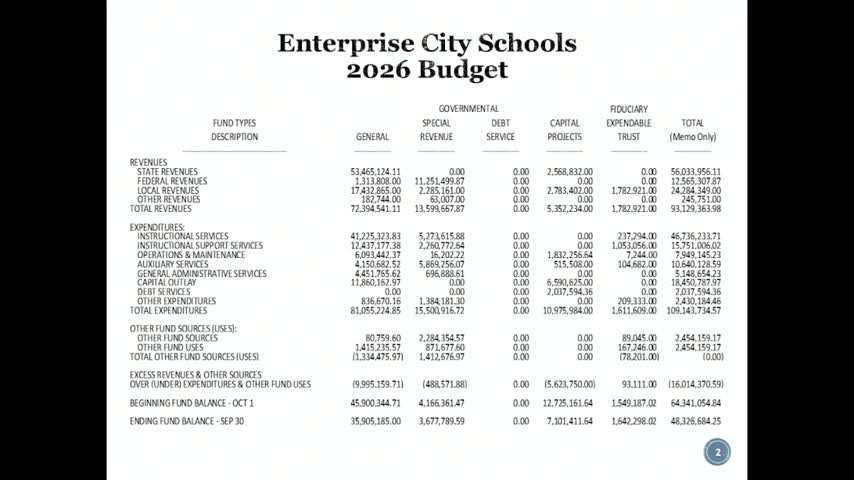School Budget Proposal Highlights $109M Expenditures and State Funding Changes
September 09, 2025 | Enterprise City Schools, School Districts, Alabama
This article was created by AI summarizing key points discussed. AI makes mistakes, so for full details and context, please refer to the video of the full meeting. Please report any errors so we can fix them. Report an error »

In the heart of Enterprise City Schools, Alabama, a pivotal budget hearing unfolded, shedding light on the financial landscape for the upcoming fiscal year. As school officials gathered under the fluorescent lights of the district office, the atmosphere was charged with anticipation and concern over the proposed budget for FY '26.
The meeting began with a detailed overview of the general fund, revealing a beginning balance of $45.09 million, which is projected to decrease to $35.09 million by the end of the fiscal year. A significant portion of this budget, approximately $7.1 million, comes from state funds designated for various educational needs, including technology and infrastructure. However, officials clarified that while this money is already in the bank, it does not represent new revenue, leading to a real reduction of about $3 million in the general fund for the upcoming year.
The discussion highlighted the complexities of funding sources, with 60% of the budget derived from state allocations, 20% from local taxes, and the remainder from federal funds and donations. Notably, the local revenue is primarily driven by sales and property taxes, which are crucial for maintaining school operations.
As the conversation shifted to expenditures, the proposed budget for FY '26 was set at a staggering $109 million, reflecting a significant increase from the previous year. This rise is attributed to additional revenues expected to flow into the district, allowing for larger investments in instructional services, which account for the bulk of spending. Teacher salaries and benefits remain the largest expense, underscoring the district's commitment to quality education.
A key point of contention arose regarding student enrollment figures, which showed a slight increase of 43.3 students from the previous year. This growth, however, did not translate into proportional funding for administrative positions, as the district lost funding for half a principal due to a threshold calculation based on student numbers. This nuance sparked questions among board members, highlighting the intricacies of state funding formulas and their impact on local staffing.
As the meeting drew to a close, the implications of the proposed budget became clear. With a focus on maintaining educational quality amidst financial constraints, the Enterprise City Schools are poised to navigate a challenging fiscal landscape. The decisions made in this hearing will shape the educational experience for students in the coming year, leaving stakeholders eager to see how the district will adapt to these financial realities.
The meeting began with a detailed overview of the general fund, revealing a beginning balance of $45.09 million, which is projected to decrease to $35.09 million by the end of the fiscal year. A significant portion of this budget, approximately $7.1 million, comes from state funds designated for various educational needs, including technology and infrastructure. However, officials clarified that while this money is already in the bank, it does not represent new revenue, leading to a real reduction of about $3 million in the general fund for the upcoming year.
The discussion highlighted the complexities of funding sources, with 60% of the budget derived from state allocations, 20% from local taxes, and the remainder from federal funds and donations. Notably, the local revenue is primarily driven by sales and property taxes, which are crucial for maintaining school operations.
As the conversation shifted to expenditures, the proposed budget for FY '26 was set at a staggering $109 million, reflecting a significant increase from the previous year. This rise is attributed to additional revenues expected to flow into the district, allowing for larger investments in instructional services, which account for the bulk of spending. Teacher salaries and benefits remain the largest expense, underscoring the district's commitment to quality education.
A key point of contention arose regarding student enrollment figures, which showed a slight increase of 43.3 students from the previous year. This growth, however, did not translate into proportional funding for administrative positions, as the district lost funding for half a principal due to a threshold calculation based on student numbers. This nuance sparked questions among board members, highlighting the intricacies of state funding formulas and their impact on local staffing.
As the meeting drew to a close, the implications of the proposed budget became clear. With a focus on maintaining educational quality amidst financial constraints, the Enterprise City Schools are poised to navigate a challenging fiscal landscape. The decisions made in this hearing will shape the educational experience for students in the coming year, leaving stakeholders eager to see how the district will adapt to these financial realities.
View full meeting
This article is based on a recent meeting—watch the full video and explore the complete transcript for deeper insights into the discussion.
View full meeting
